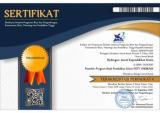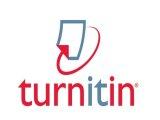Synthesis and Characterization of Porous Polymer as a Support Matrix for Lipase Immobilization
DOI:
https://doi.org/10.33394/hjkk.v13i4.16864Keywords:
Lipase, immobilization, porous polymer, porogen, glycidyl methacrylate.Abstract
Immobilization of lipase on solid supports has become a promising approach to improve enzyme stability, activity, and reusability in various industrial processes. This study focuses on the development of a porous polymer, poly(glycidyl methacrylate-co-trimethylolpropane trimethacrylate) [Poly(GM-co-TT)], as a functional support for covalent lipase immobilization. The experimental procedure included three main stages. First, Poly(GM-co-TT) was synthesized via free radical polymerization using a ternary porogenic solvent system consisting of 1,4-butanediol, 1-propanol, and water in a 4:7:1 (v/v) ratio to obtain a porous structure. Second, lipase was immobilized covalently through the reaction between epoxy groups of the polymer and amino groups of the enzyme, using a 0.2 M KCl–NaOH buffer (pH 11) at a final enzyme concentration of 10 mg/mL, incubated at room temperature for 120 minutes. Third, characterization was performed using FTIR spectroscopy and scanning electron microscopy (SEM) to verify successful immobilization. FTIR analysis revealed the presence of ester (C=O), ether (C–O–C), and epoxide (C–O) groups in the polymer. Post-immobilization spectra showed reduced epoxy band intensity (~910 and 840 cm⁻¹) and the appearance of amide bands (~1640–1660 cm⁻¹), indicating covalent bonding between polymer and enzyme. SEM images confirmed a porous, globular, interconnected morphology with well-distributed pores, ideal for enzyme anchoring. The open and rough surface increases surface area, enhancing immobilization efficiency. The novelty of this study lies in employing Poly(GM-co-TT) as a porous polymer that preserves epoxy functionality while effectively supporting covalent lipase immobilization.
References
Amalia, S., Angga, S. C., Iftitah, E. D., Septiana, D., Anggraeny, B. O. D., Warsito, Hasanah, A. N., & Sabarudin, A. (2021). Immobilization of trypsin onto porous methacrylate-based monolith for flow-through protein digestion and its potential application to chiral separation using liquid chromatography. Heliyon, 7(8), e07707. https://doi.org/10.1016/j.heliyon.2021.e07707
Giraldo, L., Gómez-Granados, F., & Moreno-Piraján, J. C. (2023). Biodiesel Production Using Palm Oil with a MOF-Lipase B Biocatalyst from Candida Antarctica: A Kinetic and Thermodynamic Study. International Journal of Molecular Sciences, 24(13). https://doi.org/10.3390/ijms241310741
Hasanah, A. N., Maelaningsih, F. S., Apriliandi, F., & Sabarudin, A. (2020). Synthesis and Characterisation of a Monolithic Imprinted Column Using a Methacrylic Acid Monomer with Porogen Propanol for Atenolol Analysis. Journal of Analytical Methods in Chemistry, 2020, 1–15. https://doi.org/10.1155/2020/3027618
Lyu, X., Gonzalez, R., Horton, A., & Li, T. (2021). Immobilization of Enzymes by Polymeric Materials. Catalysts, 11(1211), 1–15. https://doi.org/https:// doi.org/10.3390/catal11101211
Maghraby, Y. R., El-shabasy, R. M., Ibrahim, A. H., & Azzazy, H. M. E. (2023). Enzyme Immobilization Technologies and Industrial Applications. ACS Omega, 8, 5184–5196. https://doi.org/10.1021/acsomega.2c07560
Mandari, V., & Kumar, S. (2022). Biodiesel Production Using Homogeneous , Heterogeneous , and Enzyme Catalysts via Transesterification and Esterification Reactions : a Critical Review. BioEnergy Research, 935–961. https://doi.org/10.1007/s12155-021-10333-w
Miletic, N., Rohandi, R., Vukovic, Z., & Nastasovic, A. (2009). Surface modification of macroporous poly ( glycidyl methacrylate- co -ethylene glycol dimethacrylate ) resins for improved Candida antarctica lipase B immobilization. Reactive & Functional Polymers, 69(2009), 68–75. https://doi.org/10.1016/j.reactfunctpolym.2008.11.001
Sabarudin, A., Shu, S., Yamamoto, K., & Umemura, T. (2021). Preparation of metal-immobilized methacrylate-based monolithic columns for flow-through cross-coupling reactions. Molecules, 26(23), 1–14. https://doi.org/10.3390/molecules26237346
Sarmah, N., Revathi, D., Rani, Y. . ., Sridhar, S., Mehtab, V., & Sumana, C. (2017). Recent Advances on Sources and Industrial Applications of Lipases. Biotechnology Progress, 34(5–18), 1–67. https://doi.org/10.1002/btpr.2581
Septiana, D., Angga, S. C., Amalia, S., Iftitah, E. D., & Sabarudin, A. (2018). Modification of monolithic stationary phase using human serum albumin as chiral separation. AIP Conference Proceedings, 2021(2018). https://doi.org/10.1063/1.5062754
Xie, W., & Huang, M. (2020). Fabrication of immobilized Candida rugosa lipase on magnetic Fe3O4-poly(glycidyl methacrylate-co-methacrylic acid) composite as an efficient and recyclable biocatalyst for enzymatic production of biodiesel. Renewable Energy, 158, 474–486. https://doi.org/10.1016/j.renene.2020.05.172
Downloads
Published
How to Cite
Issue
Section
Citation Check
License
License and Publishing Agreement
In submitting the manuscript to the journal, the authors certify that:
- They are authorized by their co-authors to enter into these arrangements.
- The work described has not been formally published before, except in the form of an abstract or as part of a published lecture, review, thesis, or overlay journal.
- That it is not under consideration for publication elsewhere,
- That its publication has been approved by all the author(s) and by the responsible authorities – tacitly or explicitly – of the institutes where the work has been carried out.
- They secure the right to reproduce any material that has already been published or copyrighted elsewhere.
- They agree to the following license and publishing agreement.
Copyright
Authors who publish with Hydrogen: Jurnal Kependidikan Kimia agree to the following terms:
- Authors retain copyright and grant the journal right of first publication with the work simultaneously licensed under a Creative Commons Attribution License (CC BY-SA 4.0) that allows others to share the work with an acknowledgment of the work's authorship and initial publication in this journal.Â
- Authors are able to enter into separate, additional contractual arrangements for the non-exclusive distribution of the journal's published version of the work (e.g., post it to an institutional repository or publish it in a book), with an acknowledgment of its initial publication in this journal.
- Authors are permitted and encouraged to post their work online (e.g., in institutional repositories or on their website) prior to and during the submission process, as it can lead to productive exchanges, as well as earlier and greater citation of published work.
Licensing for Data Publication
Hydrogen: Jurnal Kependidikan Kimia uses a variety of waivers and licenses, that are specifically designed for and appropriate for the treatment of data: Open Data Commons Attribution License, http://www.opendatacommons.org/licenses/by/1.0/ (default) Other data publishing licenses may be allowed as exceptions (subject to approval by the editor on a case-by-case basis) and should be justified with a written statement from the author, which will be published with the article.









